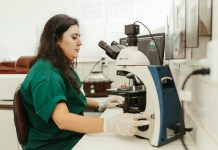
The pancreas, an inconspicuous organ nestled behind the stomach, plays a pivotal role in our bodies.
It generates enzymes that facilitate food digestion and hormones that regulate blood sugar levels.
However, like many bodily components, the pancreas can encounter issues, including the formation of cysts – small, fluid-filled sacs.
While most cysts remain benign, some possess the potential to evolve into cancer, particularly pancreatic cancer, a perilous malignancy often detected at advanced stages.
Researchers at Duke Health have been diligently exploring a method to identify cysts with the potential to progress into cancer before the transformation occurs.
Their findings, published in the journal Science Advances, could mark a significant breakthrough in pancreatic cancer detection and prevention.
Why Early Detection Matters
Pancreatic cancer poses a substantial challenge due to its propensity to metastasize quickly, even when detected at an early stage.
Dr. Peter Allen, Head of the Surgical Oncology Division at Duke University School of Medicine, emphasizes the importance of this research.
“Even when pancreas cancer is detected at its earliest stage, it almost always has shed cells throughout the body, and the cancer returns,” he states.
The majority of cysts, specifically intraductal papillary mucinous neoplasms (IPMNs), do not progress to cancer. However, discerning which IPMs might undergo malignant transformation is pivotal in preventing pancreatic cancer.
The research team harnessed modern technology, specifically digital spatial RNA profiling, to investigate specific regions of cysts exhibiting abnormal cell growth.
This advanced approach outperformed previous methods by providing precise genetic markers that indicate cancer risk or protection.
The research identified various genetic changes within the cysts, some with carcinogenic potential and others seemingly inhibitory to cancer development.
Additionally, the team discovered markers distinguishing between two common IPMN types and identified markers for a third, generally less aggressive type.
Future Applications
While this discovery marks a crucial milestone, Dr. Allen asserts that further progress is essential.
The team’s next objective is to identify these unique markers within the cyst fluid, paving the way for a protein biopsy that could guide the decision to remove a cyst before cancerous transformation.
Current pancreatic cancer diagnosis methods yield approximately 60% accuracy. Dr. Allen and his team hope to substantially enhance this rate with their newfound knowledge.
Moreover, as pancreatic cancer incidence rises, researchers are exploring potential connections between inflammation and cancer development. They are currently testing anti-inflammatory therapies to reduce risk in IPMN patients.
Pancreatic cancer is an escalating concern, and early detection remains the key to improving patient outcomes. Dr. Allen’s research has the potential to revolutionize early detection and prevention strategies, ultimately saving lives.
This groundbreaking research, conducted in collaboration with Matthew K. Iyer, Chanjuan Shi, Austin M. Eckhoff, Ashley Fletcher, and Daniel P. Nussbaum, could significantly enhance our ability to combat pancreatic cancer.
If you care about cancer, please read studies about how to reduce pancreatic cancer spread by nearly 90%, and green tea could help reduce death risk in type 2 diabetes.
For more information about cancer, please see recent studies about a new way to increase the longevity of cancer survivors, and results showing vitamin D supplements strongly reduce cancer death.
If you care about cancer, please read studies about a new method to treat cancer effectively, and this low-dose, four-drug combo may block cancer spread.
For more information about cancer prevention, please see recent studies about nutrient in fish that can be a poison for cancer, and results showing this daily vitamin is critical to cancer prevention.
Follow us on Twitter for more articles about this topic.
Copyright © 2023 Knowridge Science Report. All rights reserved.



